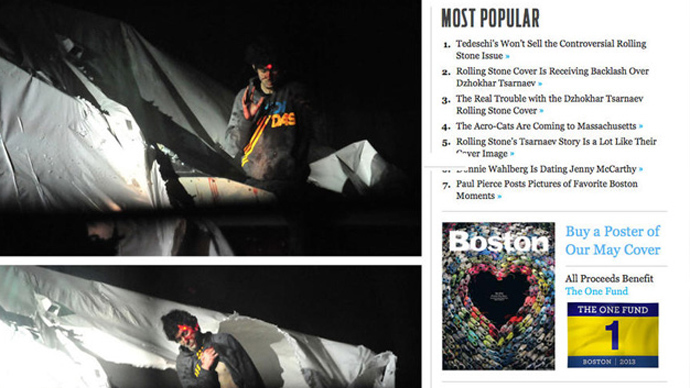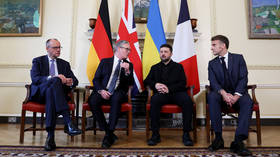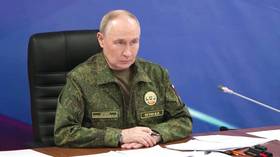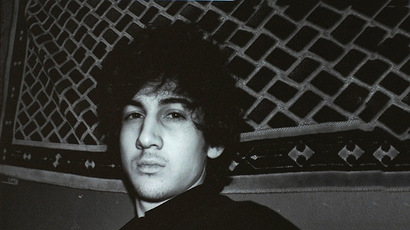'Face of terror': Boston sgt suspended over leak of Tsarnaev's arrest photos

After Boston Magazine published previously unseen photographs of the night of suspected Boston Marathon bomber Dzhokar Tsarnaev’s capture, in response to a now controversial Rolling Stone cover, the man who released the pictures has had his badge revoked.
The new images, which were provided by Sgt. Sean Murphy, a
tactical photographer with the Massachusetts State Police, were
accompanied by a statement written by Murphy, who was angered by
the magazine cover of Tsarnaev, arguing that it promoted an
unfair image of the suspected terrorist.
“The truth is that glamorizing
the face of terror is not just insulting to the family members of
those killed in the line of duty, it also could be an incentive
to those who may be unstable to do something to get their face on
the cover of Rolling Stone magazine,” wrote Murphy.
Sgt. Sean Murphy has been relieved of duty. Post coming shortly.
— John Wolfson (@johnwolfson) July 19, 2013
On Thursday evening Murphy told CNN that he had been placed on
leave from his job pending a review next week. Earlier in the
day, a police spokesman had told reports that the agency had not
authorized publication of the photos Murphy had taken.
“Today’s dissemination to
Boston Magazine of photographs of Boston Marathon bombing suspect
Dzhokar Tsarnaev and police activity related to his capture was
not authorized by the Massachusetts State Police. The department
will not release the photographs to media outlets. The State
Police will have no further comment on this matter
tonight.”
Unlike the Rolling Stone cover, which takes what critics describe
as a glamorous, stylized portrait of the youngest Tsarnaev
brother - the eldest having been killed during a confrontation
with police - Murphy’s photographs depict Tsarnaev at the moment
of his capture, bloodied and emerging from a boat in the
residential backyard where police converged on him in Watertown,
Massachusetts just prior to his surrender.
Most striking to what has become that key image is a sniper’s
clearly visible red laser target on Tsarnaev’s forehead as he
surrenders to authorities.
Another pic of #Tsarnaev with a red laser sight dot on his forehead via http://t.co/KIKqEH1uBQpic.twitter.com/X4dSdBaEfx
— Egor Sheremet (@Sheremet_RT) July 18, 2013
Additional images taken on April 19 show Tsarnaev lying on the
ground and receiving emergency medical care, as well as photos of
police and emergency response workers during the manhunt through
the Boston suburbs.
"This guy is evil,"
Murphy tells Boston magazine. "This is the real Boston bomber. Not
someone fluffed and buffed for the cover of Rolling Stone
magazine."
BOSTON MAG HAS NEW PICS FROM TSARNAEV APPREHENSION pic.twitter.com/65w1j8YKF9
— Mindia Gavasheli (@snakeeate) July 18, 2013
Though Rolling Stone is known for producing controversial images, these are generally of individuals remarkable for their musical or cultural impact. The choice to depict the bombing accomplice on its cover has been interpreted by many as offensive to his victims.
According to Murphy, who is also responsible for photographing the funeral ceremonies of police officers, the August magazine cover is a sad reminder for victims of the bombings.
“It’s irritated the wounds that will never heal—again. There is nothing glamorous in bringing more pain to a grieving family.”
A number of Boston-area and US retail chains said on Wednesday that they would not stock the Rolling Stone edition out of concern from the developing controversy.















